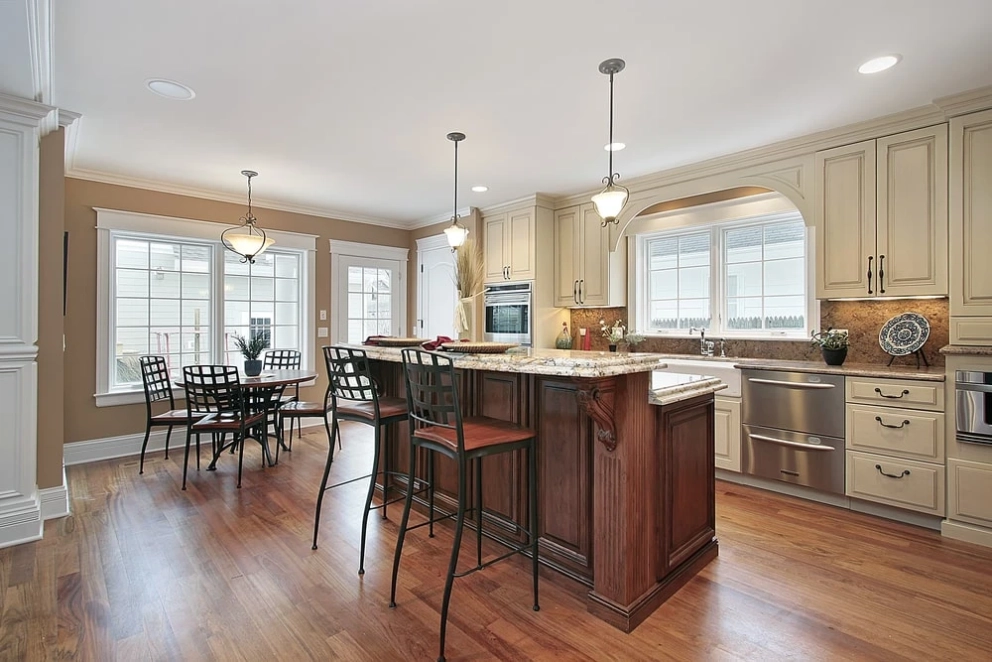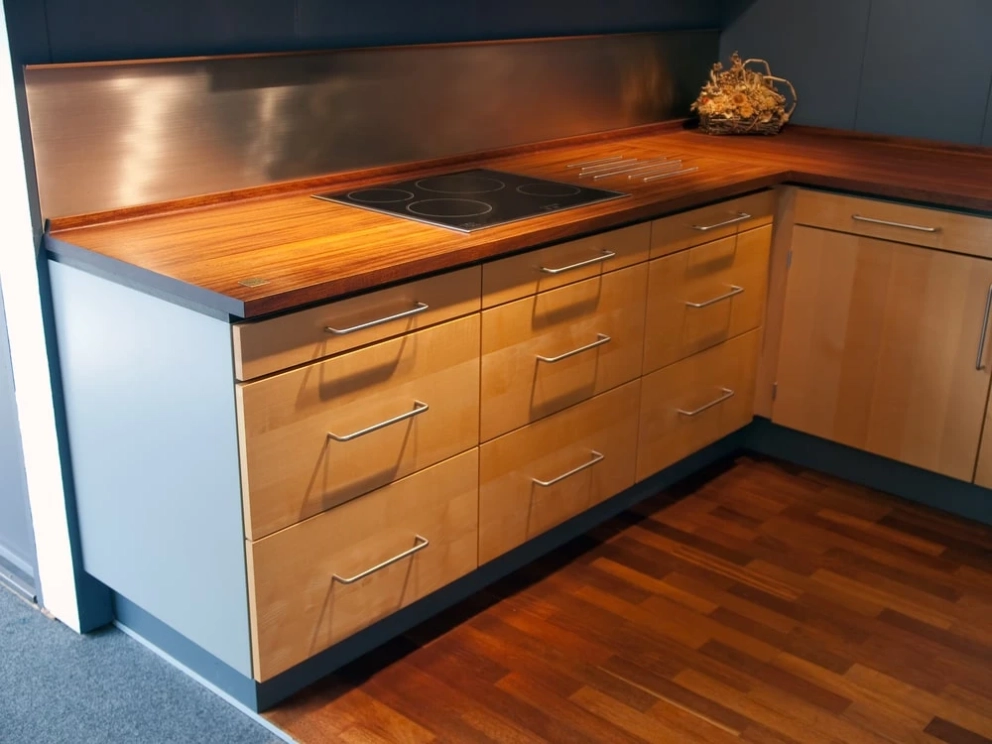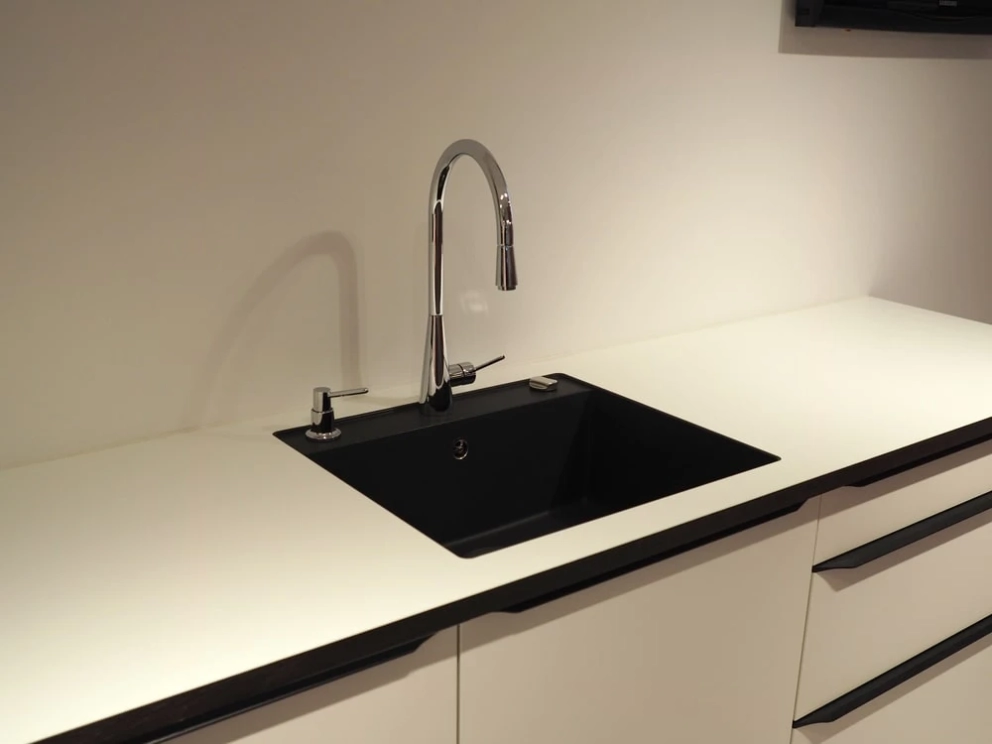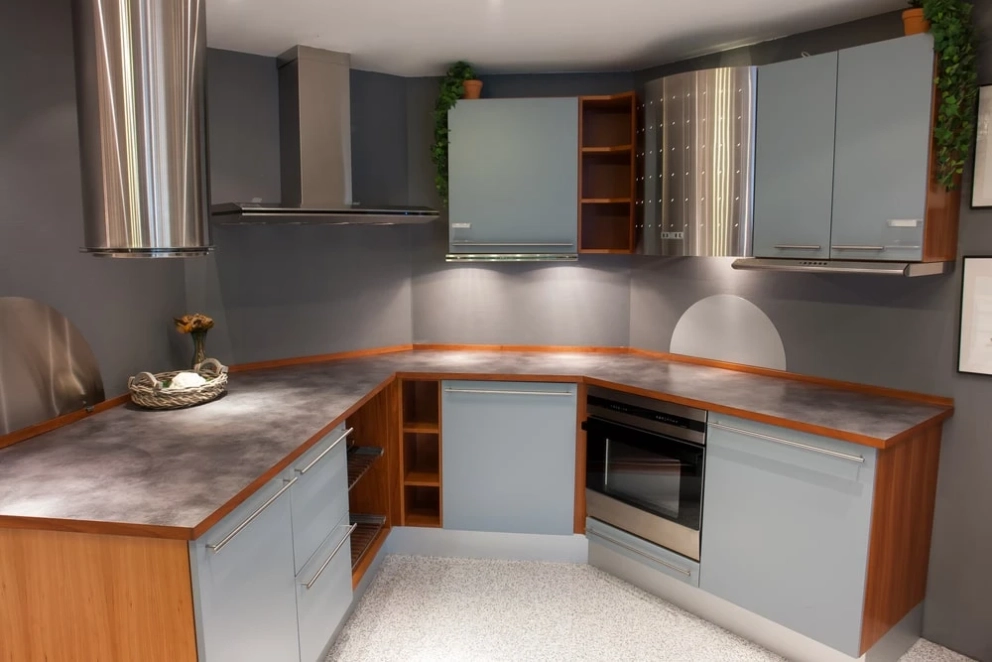Kitchen countertop edge features - Find the best way to trim your countertop

There are many aspects to consider for a successful renovation. Everything is important - from the layout and size of cupboards and aisles to the finishing and final details. The finishing touch for your kitchen countertop installation is the edge profile. When buying a new countertop, you can choose the countertop edge profile that suits your kitchen style.
When choosing a countertop, it is important to pay attention to the countertop edge profiles. The countertop front edges are what most often reveal the material; the processing of the countertop back edge shows the quality of the material itself, as well as the skill of the manufacturer. The way modern countertop edge is trimmed is important to maintain the integrity of the countertop - for example, if the counter material is not solid like granite, but laminate or wood, then if improperly processed, the edge can be subject to changes in humidity and heat and deteriorate over time.
With today's variety of kitchen designs and decoration ideas, there are many countertop edge types. Bevelled, bullnose, or ogee edges - they all have an impact on how sophisticated and complete your new kitchen will look. When planning your renovation, you should not only think about the aesthetic beauty of the worktop, but also its long-term use. Some countertop edges look very sleek and fancy, but due to the material's structure, they are prone to chipping. While standard countertop edges like bullnose are considered timeless and the easiest to maintain.
In this Cut2Size blog, we will explore different edges and their features. After reviewing all the options, you can make an informed choice of the countertop edge finish that suits you best.
Countertop edge types

The choice of edge profile can impact the overall aesthetics, comfort, and durability of your countertops. In this guide, we'll explore 14 different single-edge countertop styles, each with its unique features and design possibilities.
| Kitchen countertop edge styles | Features |
| Eased edge countertop | A countertop eased-edge profile is perhaps the most common type of edging seen in modern kitchens. An eased countertop edge is characterized by a slightly rounded look for a clean and contemporary aesthetic. Homeowners and designers often opt for a countertop eased edge if they want a simple and understated look. Additionally, a countertop edge eased requires easy maintenance. |
| Square edge countertop | A square countertop edge, in contrast to an eased edge, is prominently sharp and right-angled. It is best for industrial and modernist kitchens. Straight countertop edge, as its name implies, features clean straight lines for a sleek and straightforward design. |
| Pencil edge countertop | A pencil round countertop edge is rounded like a pencil but offers a subtle decorative touch. It has a gentle and softly rounded profile, which is ideal for a much more eccentric type of kitchen design. |
| Rounded countertop edge | A round-edge countertop features a smooth, curved profile, adding a soft and inviting touch to your countertop. When creating a round-over countertop edge, use the 1/8” round countertop edge principle which is basically taking off the 1/8” radius of the material from the countertop. This design is not only aesthetically pleasing but also practical, reducing the risk of chipping and making it comfortable for leaning at the counter. |
| Bevel/bevelled edge countertop | The bevel countertop edge is characterized by a subtle angled cut along the top, adding a touch of sophistication and depth to the countertop. The profile of a beveled countertop edge complements various design styles, from modern to transitional, and offers a sleek, elegant look. The standard countertop beveled edge is made by polishing ¼ bevel edge countertop corners to create a flat edge at a 45-degree angle. The most common type of bevel countertop is the bevel edge laminate countertop. A beveled wood edge laminate countertop is considered a classic detail in traditional kitchens. |
| Mitered edge countertop | A mitre edge countertop is created by joining two pieces of material at a seamless 45-degree angle, offering a clean and polished appearance often favoured for kitchen islands. Available in varying thicknesses - such as 1.5, 2, and 3 inches—the thicker the edge, the higher the cost due to the added material and stability required for a durable edge banding. This design choice not only enhances the countertop's sophistication but also eliminates visible seams for a sleek, uninterrupted look. |
| Knife edge countertop | The knife edge, also known as a double-bevel edge, features a sharp, angled edge that resembles a knife blade. This contemporary and minimalist design adds a bold statement to the countertop, emphasizing clean lines and modern aesthetics. |
| Ogee edge countertop | An ogee countertop edge is elegant and ornate, featuring an S-shaped curve that adds a touch of classic sophistication to the countertop. This decorative og edge countertop profile is often chosen for traditional and luxurious kitchen designs, creating a timeless and refined appearance. |
| Bullnose edge countertop | The bullnose countertop edge is fully rounded on the top and bottom, creating a smooth, graceful contour. This classic edge profile eliminates sharp corners, making it safe and easy to clean, and offers a timeless look suitable for various kitchen styles. |
| Live edge countertop | A live-edge kitchen countertop retains the natural edge of the wood slab, showcasing the raw, organic beauty of the material. This is often referred to as a chiselled countertop edge because it is created by manually chiselling or carving the edge of the stone. This design choice celebrates the wood's natural imperfections and unique character, providing a rustic and one-of-a-kind appearance to the countertop. An epoxy live-edge countertop is applied to smooth the chiselled texture. Live-edge countertops are available in countertop manufacturing stores in Canada. You can always choose to do the chiselling on your own, but make sure to apply live-edge epoxy countertop for a smoother finish on your counter’s edges and corners. |
| Double edge countertop | Double square edge countertops combine two distinct edge profiles, often with the upper edge rounded or beveled and the lower edge straight. This bold double-radius countertop edge design choice adds depth and complexity to the countertop, making it a standout feature in any kitchen or bar. Another variation of the double-edge style is the double pencil edge countertop. It is created by using a tool that polishes the edges of the countertop. |
| Drip edge countertop | Drip edges are primarily used in construction to direct water away from surfaces. In the context of countertops, a countertop drip edge design is more functional than decorative, ensuring water and other liquids do not seep onto cabinets or floors, and offering a practical solution for wet areas. |
| Apron edge countertop | The apron edge features an underhang, creating a thicker appearance at the edge of the countertop. This design adds visual weight and depth, often chosen for kitchen islands or bars, providing a substantial and substantial look to the countertop. |
Countertop edge detail options

The choice of countertop front edge is crucial as it not only adds a decorative touch but also plays a practical role in protecting the countertop from chipping and wear. Additionally, the edge of the countertop can provide a comfortable surface to lean against and create a polished, cohesive look in your kitchen or bathroom. When considering countertop options, be sure to select one that complements your overall design, ensuring your countertop edge is not only visually appealing but also durable and functional. Here are some of the most popular material choices.
- Wood
A wood edge countertop adds warmth and character to your space. They are a fantastic choice for those seeking a rustic or traditional look. These edges can be created using various wood species. Examples of these are a live-edge oak countertop and a plywood edge countertop. Each offers its unique grain pattern and colour.
A live-edge wood countertop not only provides a charming, organic touch but also offers a comfortable surface for leaning or sitting. It's essential to maintain and seal wood edges regularly to prevent moisture damage and ensure longevity. - Concrete
If you want something timeless, go for a concrete countertop edge. Concrete countertop edges bring an industrial and contemporary vibe to your space. They are known for their durability and versatility, allowing for customization in terms of colour and texture. A live-edge concrete countertop can be shaped in various profiles, from sleek and minimalistic to more intricate designs.
There are concrete countertops that you can purchase here in Canada. You can choose from a variety of decorative edges. If your aim is to create a rustic and distressed countertop look, a chiselled-edge concrete countertop is your best option to achieve this look. - Tile
Tile countertop edge ideas are a practical and stylish choice for countertops. They offer a wide range of design possibilities with various shapes, sizes, and colours to choose from. A tile countertop edge can be used to create intricate mosaic patterns, or it can provide a clean and cohesive look, depending on your preference. Tile edges are also available in different materials. You can opt for a stone, laminate, or tile countertop with a wood edge. A tile edge countertop is especially well-suited for bathrooms and kitchens where moisture resistance is crucial. - Laminate
Laminate countertop edge profiles are a budget-friendly option that offers a wide range of colours and patterns to match your decor. Laminate countertop edge styles are easy to maintain and resistant to stains and water damage. Laminate countertops are also available in a variety of edge styles. Some of these are bullnose, crescent-edge, and square-edge laminate countertops. Laminate countertop edge options can be customized to emulate the look of more expensive materials like stone or wood, making them a cost-effective choice for homeowners who want an attractive finish without breaking the bank. - Stone
Stone countertop edge profiles are a timeless and luxurious choice for countertops. Natural stone edges may require periodic sealing to maintain their pristine appearance, while engineered stone edges are typically more resistant to staining and require less maintenance. Stone countertop edges, such as those made from marble, granite, and quartz, are renowned for their luxurious aesthetics and durability. Each stone material offers unique options for edge profiles that can elevate the look of your countertops.
Marble countertop edge profiles exude timeless elegance and are known for their classic beauty. While there are various profiles available, a popular choice is a bevelled edge, featuring a subtle, angled cut along the top. This profile adds a touch of sophistication and highlights the natural veining of the marble, making it a favourite for those seeking a traditional and refined appearance.
A granite countertop edge is prized for its durability and natural beauty. The granite countertop eased edge is a popular choice, characterized by a gently rounded top edge that provides a sleek and modern look. Eased-edge granite countertop is not only aesthetically pleasing but also functional, as the eased edge minimizes chipping and provides a comfortable surface.
Quartz countertop edge profiles offer excellent versatility in edge profiles. Similar to granite, there are also a variety of quartz countertop edge types. These are eased-edge countertop quartz, rounded, and double-edge. The quartz countertop eased edge is a clean, straight edge with slightly softened corners, suitable for contemporary and transitional designs. The rounded-edge quartz countertop features a more pronounced curve, offering a softer and more inviting appearance, which can be perfect for traditional or casual spaces.
For a bolder statement, the double-edge quartz countertop combines two distinct edge profiles, often with the upper edge rounded or beveled and the lower edge straight, creating a unique and dynamic countertop appearance. Quartz countertop edge finishes allow homeowners to tailor their quartz countertop edge profiles to match their specific style preferences and overall design scheme.
Laminate countertop edge treatments

Laminate countertop edge treatments play a pivotal role in enhancing the aesthetics and durability of your kitchen surfaces.
To replace a laminate countertop edge, the process typically involves carefully removing the old edge, cleaning the surface, applying fresh adhesive, and securing the new edge treatment in place. It's essential to follow manufacturer guidelines and take precision when measuring and cutting the laminate to achieve a professional and polished finish for your countertops.
When it comes to affixing the laminate edge to the countertop, it's crucial to choose the best glue for the countertop edge, typically a solvent-based contact cement. This adhesive ensures a strong and long-lasting bond between the laminate and the countertop substrate. The same type of adhesive is often used for laminate countertop edge banding to cover and protect the exposed edge of the countertop, creating a seamless look and safeguarding against moisture and impact damage.
How to fix a chip in a quartz countertop edge?
Let’s say, for example, you discovered a chipped countertop edge. To repair a chipped quartz countertop edge might sound daunting, but it's actually quite manageable. Start by collecting a few essential items: epoxy resin, and if available, a pigment to match your countertop colour, a mixing tool, a putty knife, and some fine-grit sandpaper. Now, let's walk through the steps on how to repair a chip in a quartz countertop edge. Clean the area of the chipped quartz countertop edge to remove any dirt. Next, mix the epoxy resin with pigment, if needed, for a colour match.
Apply this mixture to the chip, making sure it's level with the rest of the countertop. After allowing it to cure, polishing the quartz countertop edge is next. Gently sand the repaired area until it's smooth and blends seamlessly with the surrounding edge. This DIY process should do a fantastic job of concealing that chip on your mitred-edge quartz countertop, but remember, if you're not entirely confident, consulting a professional is a wise option for the best results.
How to repair a chipped granite countertop edge?
The process for repairing a chipped countertop made of granite is generally similar to repairing one made of quartz, but there may be some subtle differences due to the distinct characteristics of these materials. When doing a chipped granite countertop edge repair, begin by cleaning the chipped area to remove dirt and debris. Next, fill the chip with an epoxy resin that matches the colour of your granite.
Allow the epoxy to cure according to the manufacturer's instructions, usually around 24 hours. After curing, use fine-grit sandpaper to smooth and blend the repaired area with the surrounding granite edge. This process should effectively conceal the chip and restore the appearance and integrity of your granite countertop edge. For a professional finish or if you have any doubts, it's advisable to consult a stone countertop specialist.
Countertop edge trimming

A countertop edge trim, also known as edge banding or edge moulding, is a decorative and protective kitchen countertop edge protector applied to the exposed edges of a countertop. There are different types of materials from which edge trims are made. These are the most common:
- Rubber countertop edge trim
Rubber countertop edging offers a flexible and durable solution. It's particularly well-suited for high-traffic areas, as it provides excellent impact resistance and helps protect the countertop's edge from chipping. Rubber trim is available in various colours and profiles, making it a versatile choice for both design and practicality. - Laminate countertop edge trim
Laminate edge trim is recommended for those seeking a seamless and budget-friendly finish. Laminate countertop edge strips are designed to match the countertop's surface, creating a cohesive look. Laminate trim is relatively easy to install and provides added protection against moisture and chipping. While it may not offer the same level of sophistication as other materials, it excels in durability and ease of maintenance. - Metal countertop edge trim
Metal edge trim, often made of materials like stainless steel or aluminum, adds a touch of modern sophistication to your kitchen worktop. It offers exceptional durability and resistance to wear and tear. Metal countertop edge trim in Canada can be purchased or custom-ordered on Cut2Size. Metal trim can be sleek and minimalistic or more decorative, depending on your design preferences. - Vinyl countertop edge trim
Vinyl countertop edging is a cost-effective choice that provides both protection and design versatility. It's available in various colours and profiles, allowing you to match it to your countertop or create a contrasting accent. High-quality plastic countertop edge trim is a practical and affordable solution for edge protection. - Tile countertop edge trim
Countertop tile edge trim is an ideal choice for those looking to incorporate decorative elements into their countertop design. It allows for endless design possibilities, with various tile shapes, sizes, and colours to choose from. A flexible countertop edge trim can create intricate mosaic patterns or provide a clean and cohesive finish, adding both style and protection. - Granite countertop edge trim
Granite countertop edge trim, made from the same material as the countertop, offers a luxurious and seamless look. This option is perfect for those who want their granite countertops to shine from every angle. It not only provides protection but also enhances the overall aesthetic appeal, showcasing the natural beauty of the stone.
Island counter edge

The island countertop is a focal point in many kitchens, and the choice of its edge design can significantly impact the overall aesthetics of the space. Two popular and visually striking options for kitchen island countertops are the waterfall edge countertop and the live edge island countertop.
Waterfall countertop edge
The countertop waterfall edge is a design choice where the countertop material gracefully extends vertically down the sides of the island, giving the appearance of a continuous surface that "waterfalls" from the top to the floor. This sleek and modern waterfall countertop edge profile not only provides a stunning visual effect but also offers a seamless and clean look, which is highly desirable for contemporary kitchen designs.
A countertop with a waterfall edge can be especially practical with materials like marble or quartz, creating a sophisticated and luxurious feel in the kitchen. A waterfall-edge granite countertop is highly resistant to heat, scratches, and staining, making it a durable option that can withstand the rigours of a busy kitchen.
A waterfall edge countertop laminate, on the other hand, is a cost-effective choice which is ideal for homeowners with budget constraints who want to achieve a stylish look without breaking the bank.
If you want to create a kitchen that looks timeless and can be complemented with any kind of décor and aesthetic style, opt for a kitchen countertop with a waterfall edge. They come in various colours and patterns. A false quartz countertop with a waterfall edge may be quite affordable and also mimics the look of natural stone while offering a more uniform appearance.
Live-edge countertop
In contrast to the clean lines of the waterfall edge, the live edge countertop embraces a more rustic and natural aesthetic. Live-edge countertops feature the raw, natural edge of the wood or stone slab, retaining the organic shapes and imperfections found in the original material.
This design choice brings a sense of uniqueness and character to the kitchen, as each live-edge countertop is distinct. It's an ideal choice for homeowners seeking a more eclectic or earthy look in their kitchen design.
Bar counter edge
When it comes to bar countertops, the live-edge countertop bar design stands out as an exceptional choice. Live-edge bar countertops not only bring a touch of nature and uniqueness to the home bar but also infuse warmth and character. The natural, irregular edge of the wood adds a rustic and inviting feel, making it a perfect option for creating a cozy and welcoming atmosphere in a kitchen or living room.
This design choice celebrates the beauty of imperfections, allowing homeowners to appreciate the raw and organic charm of the wood. It's an excellent way to make a bar counter a standout feature that enhances the overall appeal of the kitchen.
Hints and tips on choosing the edge form

In this post, we delve into the nuances of different edge forms, focusing on the classic battle between the most popular types of counter edges. Whether you lean towards the softness of curves or the sharpness of clean lines, this exploration will empower you to transform your countertops into captivating focal points that harmonize seamlessly with your overall design concept.
- Eased edge vs square edge countertop
When considering the comparison between the eased edge and square edge countertops, it becomes evident that these edge profiles cater to distinct design preferences. The eased edge offers a subtly rounded, more comfortable appearance, perfect for those who appreciate a gentle, inviting feel in their space.
In contrast, the square edge countertop stands out with its sharp, right-angled lines, making it the go-to choice for a modern and minimalist look. The decision between these two profiles essentially boils down to whether you prefer the softness of curves or the crispness of clean lines, allowing you to tailor your countertops to your unique design vision. - Mitered edge countertop vs beveled
The mitered edge countertop diverges from the beveled edge in a bevel direction. Mitered edges may be particular or involve joining two pieces of countertop material at a 45-degree angle, effectively eliminating visible seams for a seamless and uninterrupted surface.
This design choice is ideal for homeowners who desire a sophisticated and polished finish in their kitchen or bathroom, giving the countertops a sense of precision and craftsmanship that regular edges may not achieve. The beveled edge adds a touch of luxury and visual intricacy to the countertop, making it an attractive option for those with a penchant for elegant aesthetics. - Pencil vs eased edge countertop
Transitioning from a pencil edge to an eased edge countertop is a shift from a softly rounded, decorative touch to a more straightforward and contemporary appearance.
The pencil edge features a gentle, rounded profile that offers a subtle and tasteful decorative element, suitable for those who appreciate a touch of elegance without going overboard. On the other hand, the eased edge offers a smoother, less pronounced curve, contributing to a sleek and modern look.

